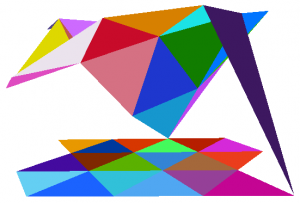Modern Music, Shapes and Persistence
Vendredi 3 avril 2015
14h30
IRCAM - Salle Stravinsky
1, place Igor Stravinsky 75004 Paris
Entrée libre
Avec la participation de Mattia Bergomi (IRCAM), Massimo Ferri (Bologna University), et Barbara Di Fabio (Bologna University).
Programme
- 14h30-15h15 : Massimo Ferri - From geometry to topology in shape description
- 15h15-16h00 : Barbara Di Fabio - Persistent homology for shape description
- 16h00-16h45 : Mattia Bergomi - A Musical Application of Persistent Homology
Résumé des interventions
From geometry to topology in shape description
Massimo Ferri
Is shape just geometric similarity? Surely not; on the other hand, the main topological type of equivalence, i.e., homeomorphism, is much too far from the human idea of "having the same shape". Still, this does not mean that we have to avoid mathematical tools in shape description, analysis, comparison, classification, retrieval… We start from the work of Jan Koenderink, seeing how differential topology yields important cues for understanding shape, and we end up with ideas and applications of persistent homology.
[Voir la vidéo]
[Fermer]
Persistent homology for shape description
Barbara Di Fabio
Interpreting and comparing shapes are challenging issues in computer vision, computer graphics and pattern recognition. Persistent homology allows us to describe shapes by means of suitable shape descriptors, the persistence diagrams. They capture both geometrical and topological features of an object by recording the homological changes and their longevity in the lower level sets of a real valued function (called a filtering function) defined on a topological space associated with the object. This seminar provides an overview of some of the most relevant results in persistent homology, the main properties of persistence diagrams and the principal aspects in the generalization to multivalued filtering functions that allow the description of shape properties with an intrinsically multidimensional nature.
[Voir la vidéo]
[Fermer]
A Musical Application of Persistent Homology
Mattia Bergomi
Musicians* use notes and chords as words of their personal dictionary to create musical phrases. Quite often, these phrases are shaped as tension patterns over time, drawing the attention of the listener to particular moments thanks to specific choices, frustrating its intuition through unexpected changes, or confirming its expectation with, for instance, a well-known cadence leading to resolution. The notion of tension has often been related to that of consonance, for which recent models developed in the XXth century have allowed one to provide explicit calculations and a quantitative method to compute it for n-notes chords. Traditionally, the geometric-oriented analysis of Music is based on isotropic spaces, we suggest a topological model belonging to the domain of symbolic-signal interaction aimed at the introduction of preferred directions in those spaces. In particular, the Tonnetz interpreted as a 2-dimensional simplicial complex is deformed via an height function computed as the consonance value of a fixed triad and the note associated to each element of its 0-skeleton. We observe how the geometric analysis of the different states of this variable geometry space leads to intuitive and interesting representations on either a melodic and harmonic superposition point of view. A direct way to achieve this information is given by the comparison, in terms of Wasserstein distance, among 0-dimensional persistent homology corner points diagrams associated to each shape generated by the action of the height function on the Tonnetz's vertices.
*This research is a joint work with Alexandre Popoff.
[Voir la vidéo]
[Fermer]
